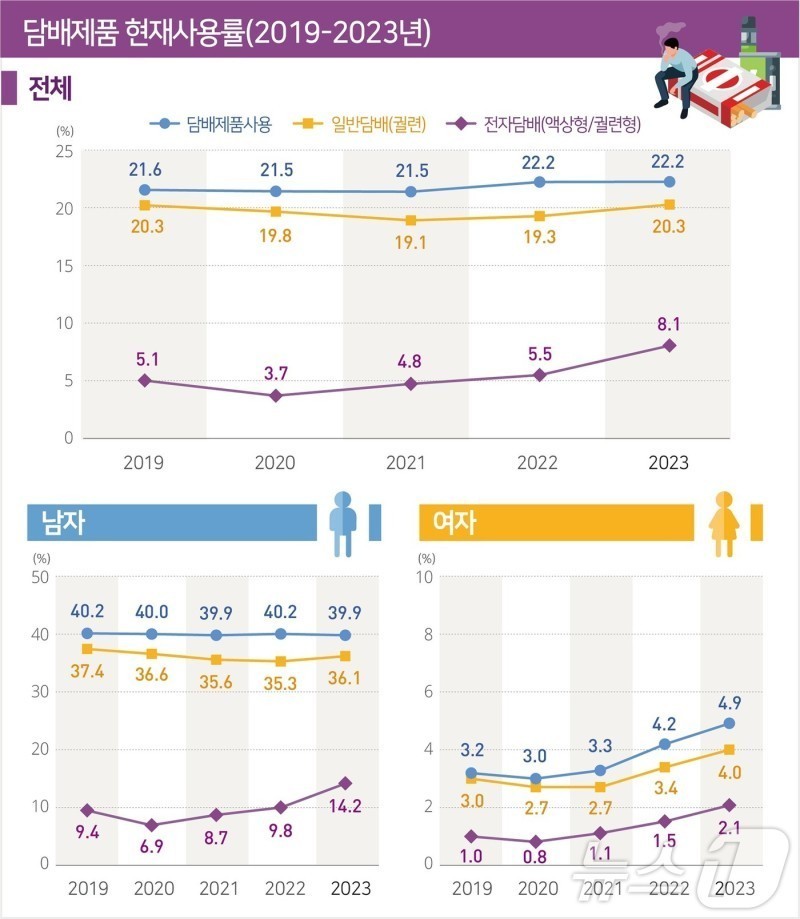
According to a report by n.news on August 27th, the Korean Disease Control and Prevention Agency recently released a survey report on adult smoking rates from 2019 to 2023. The report shows that while the smoking rate of traditional cigarettes has remained stable, the use of e-cigarettes has significantly increased. The number of smokers is mainly concentrated in the 40-year-old male and 20-year-old female groups.
A report has indicated that the smoking rate in South Korea has increased from 21.6% in 2019 to 22.2%, a rise of 0.6 percentage points. The usage rate of traditional cigarettes has remained stable, while the usage rate of e-cigarettes has increased from 5.1% in 2019 to 8.1% last year.
In terms of gender, the overall smoking rate among men has slightly decreased, from 40.2% in 2019 to 39.9% last year. However, the use of e-cigarettes has seen a significant increase, rising from 9.4% in 2019 to 14.2%. Although the smoking rate among women is lower than that of men, it is also showing an upward trend, especially with e-cigarette usage doubling in the past three years.
The smoking rates among men and women also vary across different age groups, with the highest smoking rates observed among 40-year-old men and 20-year-old women.
In terms of regions, last year the area with the highest smoking rate was Chungbuk, reaching 25.0%; while the lowest smoking rate was in Sejong, only 14.8%.
The survey also revealed that the smoking rate is higher among non-office professions, with the highest smoking rate among skilled and manual laborers reaching 34.4%.
The Director of the Department of Disease Management, Ji Youngmi, stated that smoking is the main cause of various diseases such as lung cancer, heart disease, and stroke, and can also weaken the immune system, increasing the risk of infection. She emphasized that although e-cigarettes may have a different form, they pose just as much of a health risk as traditional cigarettes, containing multiple harmful chemicals. Users should remain vigilant about the potential dangers.
We welcome news tips, article submissions, interview requests, or comments on this piece.
Please contact us at info@2firsts.com, or reach out to Alan Zhao, CEO of 2Firsts, on LinkedIn
Notice
1. This article is intended solely for professional research purposes related to industry, technology, and policy. Any references to brands or products are made purely for objective description and do not constitute any form of endorsement, recommendation, or promotion by 2Firsts.
2. The use of nicotine-containing products — including, but not limited to, cigarettes, e-cigarettes, nicotine pouchand heated tobacco products — carries significant health risks. Users are responsible for complying with all applicable laws and regulations in their respective jurisdictions.
3. This article is not intended to serve as the basis for any investment decisions or financial advice. 2Firsts assumes no direct or indirect liability for any inaccuracies or errors in the content.
4. Access to this article is strictly prohibited for individuals below the legal age in their jurisdiction.
Copyright
This article is either an original work created by 2Firsts or a reproduction from third-party sources with proper attribution. All copyrights and usage rights belong to 2Firsts or the original content provider. Unauthorized reproduction, distribution, or any other form of unauthorized use by any individual or organization is strictly prohibited. Violators will be held legally accountable.
For copyright-related inquiries, please contact: info@2firsts.com
AI Assistance Disclaimer
This article may have been enhanced using AI tools to improve translation and editorial efficiency. However, due to technical limitations, inaccuracies may occur. Readers are encouraged to refer to the cited sources for the most accurate information.
We welcome any corrections or feedback. Please contact us at: info@2firsts.com







